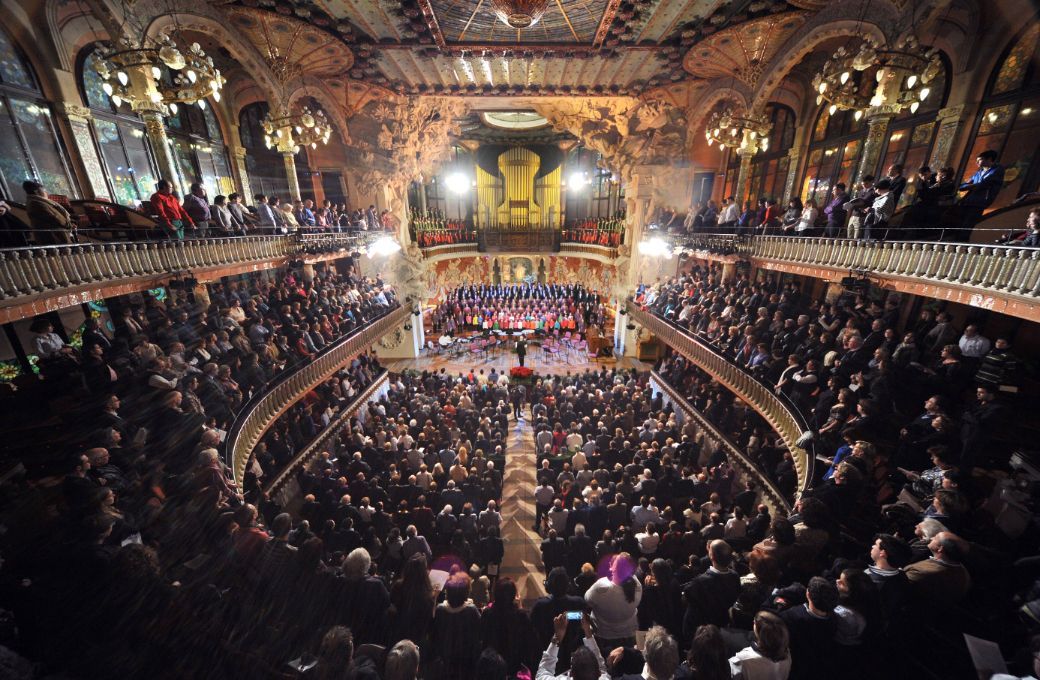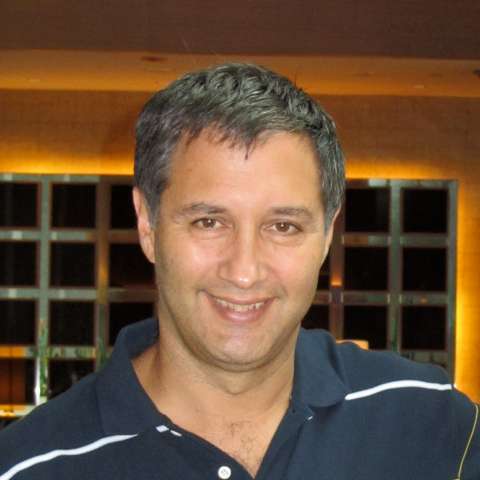Programming an annual season of 180 concerts, in a venue styling itself as the champion of music, cultural heritage and social cohesion in its region, might seem like a Sisyphean task. For Mercedes Conde Pons, however, Deputy Artistic Director of the Palau de la Música Catalana in Barcelona, it’s all in a day’s work. Conde seems remarkably unruffled as she explains how she and her team go about the business of creating such a behemoth of a season, year after year.

Indeed, the Palau has a unique governance model: it is the only major concert hall in the world founded by a community choir. The tongue-twistingly named Fundació Orfeó Català–Palau de la Música Catalana is a private entity that gets minimal government support, accounting for only 10% of its budget. The Orfeó Català choirs – six in total, a main choir and various children’s and youth choirs – remain a defining part of the foundation’s activity. (All are amateur choirs, complemented by the professional Palau Chamber Choir.)
The process of building a season is complex, filling both the main hall and the Petit Palau chamber hall with a combination of their own programming, the Orfeó Català’s choral concerts and dry-hire events. Even as the 2025–26 season gets underway, Conde and Joan Oller, the Palau’s General Director, are already finalising planning for 2026–27 and opening the book on 2027–28: such are the daunting timescales to which international venues must function.
To put some order into the chaos, Conde explains, the team starts with an “imaginary calendar” and then considers various different series: the six this year are piano, chamber, Bach, “great voices”, opera and the “Palau 100” series of international orchestras. Next, they seek out additional points of focus like anniversaries, the big one in 2026 being Manuel de Falla, born to a Catalan mother and one of Spain’s most famous composers internationally.
For an observer outside Catalonia, the most eye-catching feature of the Palau’s programming is the sheer wealth of international talent. As well as many top orchestras and period ensembles, I counted 15 pianists with a reasonable shout at being considered in the world’s top 20 – let alone some of the biggest stars of voice, violin and other instruments. I ask Conde how this is possible: “Maybe only one or two auditoriums in Spain can bring in so many major artists.”
“The Palau and l’Auditori are the only two concert halls who are members of the European Concert Hall Organisation, and run our own programming,” Conde explains. “And from our very beginnings, Palau de la Música started to look to Europe, to the north, to bring in international names. The first concerts in 1908 were from the Berliner Philharmoniker with Richard Strauss conducting. We are trying to maintain this really important place in history and have it in our DNA. But it needs much motivation and so much work!”
The objective is to build a virtuous cycle whereby audiences are attracted by the big stars, but then build up enough trust in the Palau’s programming that they will return to see less familiar repertoire and lesser-known names – who may well be younger and become the stars of the future. “The audience has developed a special connection with some artists and so to their music. We try to invite those artists frequently: the connection is between them and the audience, not with us personally. We are only a connection between the artist and the audience.”
Some of the bigger names are obvious ones – Sir Simon Rattle, Gustavo Dudamel, Anne-Sophie Mutter, Grigory Sokolov, Yuja Wang and so on – but Conde also mentions younger artists like María Dueñas, Pablo Ferrández, Beatrice Rana. For some artists, the connection is clear simply by looking at ticket sales. “Grigory Sokolov, for example, has been coming every season for the last 17 years without a break. And we know that we will sell every ticket in the concert hall. But there are some where you can feel it: in the concert, at the end of the concert, in the applause. You know that you have to react to it and give people what they want. Víkingur Ólafsson, for example, has started a beautiful relationship with the audience.”
Having said which, Conde estimates that the majority of the audience comes not just for the big names but because they trust the programming. Part of the reason that Conde feels she has her finger on the local pulse is that she spent eight years as director of the Catalan-language Revista Musical Catalana. “It was a historically very important magazine,” she relates, “that was started in the early days of the Orfeó Català and revived in the 1980s with the restoration of democracy after the end of Franco’s dictatorship. I was really involved not only in the Palau activity, but also in the whole of Catalonia’s musical activity, because I needed to know a lot about what was happening. That was very helpful for the job I’m doing now.”
Within the general mission to be the leader of classical music in Catalonia, there are three specific areas to be promoted: new music, local artists and choral music. “Every season, we put the focus on two guest composers: we always invite an international composer and a local composer. We have had Philip Glass, Steve Reich, Kaija Saariaho, Caroline Shaw, Jörg Widmann, among others.” This season will include ten pieces by Gabriela Ortíz, to include the world premiere of a choral piece sung by the Orfeó Català chamber choir. Ortíz’s local counterpart will be choral composer Josep Ollé i Sabaté, who will create several new works. “As an important institution in Catalonia, we have to bring to the audience the excellence of the music, but also the Catalan tradition.”
The building itself plays its part both financially and in feeding the audience. “We are a UNESCO World Heritage Site, one of the most important modernist buildings in Catalonia. So that means we do tourist or historical architectural visits to the building. Many people come to visit and some of them get tickets to the concert in the evening afterwards. That’s very important because it means we are getting the music activity close to an audience that maybe is not used to going to concerts.”
The challenge, of course, is to convert that wellspring into regular audience members. During the past twelve months, the Palau team have been doing a batch of surveys and analytics to better understand audience behaviour. One particular result has stuck out like a sore thumb: “80% of our audience is composed of people who have only been to the Palau once, and they don’t repeat.” Maybe, Conde suggests, they would be perfectly happy to return, but they just haven’t acquired the habit. Overcoming that inertia – by programming, by different formats and concert times, by outreach work – is high on Conde’s to-do list.
“We are developing a lot of programmes to directly get in touch with this audience, concerts that will be more appealing to a first-time visitor. We have a series of concerts with a local orchestra [the Orquestra Simfònica del Vallès] who are now developing their 30th season in the Palau.” Clearly, the familiarity helps: the concerts attract families, young people, old people.
The Orquestra’s method is to present one of the famous pieces of the repertoire, and surround it with other things to be discovered – a young soloist, a contemporary piece or one by a female composer. “Last Saturday, for example, they programmed Tchaikovsky’s Symphony no. 6, with Four Last Songs by Richard Strauss”. A recent work, Gabriela Ortíz’s Anthropolis, was also performed: “a very specific piece,” Conde says. There are also a series of talks connected with the concerts run by a university professor, Carlos Calderón, who is particularly good at making connections with the audience – the Catalans (who clearly enjoy their puns as we Brits) called the series an “MBA” for “Máster en Bona Audició” (master’s in good listening).
I can’t close without talking about choral music, particularly in a year in which, it is rumoured, Barcelona’s other great Art Nouveau landmark, Antoni Gaudí’s Sagrada Familia, will be finally completed (at least in terms of its outside structure). The Orfeó Català choirs will be involved in the celebrations, of course, but they have other big events lined up: “This year, we have started to prepare the Missa Solemnis. We will perform it in Barcelona twice before going to LA in February 2026 as the guests of Dudamel and Los Angeles Philharmonic Orchestra in his last season as musical director there. We have been invited by Kirill Petrenko and the Berliner Philharmoniker in the past. That happens not only with the big choir but also with the children’s and youth choirs: we try to manage this kind of experience from the beginnings. Now, for example, our children’s choir are performing Janáček’s The Cunning Little Vixen at the Liceu.”
There are more concerts than ever in Barcelona, Conde says. “We are competing with a lot of different inputs in the digital world, but also in culture, in the artistic world. We have more competition than ever, but that means we have more activity than ever. I think this is good news, and it’s why I feel optimistic!”
See upcoming events at Palau de la Música Catalana.
This article was sponsored by Palau de la Música – Orfeó Català


